There’s a lot more to creating an exceptional blog post than just writing great content. Find out about the 10 essential elements that can elevate your website’s blog and SEO.
10 Essential Elements of an Exceptional Blog Post
Author: Albert Konik, Senior Content Writer

What makes a blog post exceptional?
If only more content writers asked themselves that question before writing, maybe we wouldn’t be flooded with tons of low-quality content. But here we are. Most of the written content you find online is, how to put it kindly… hopeless.
However, even the blog posts that, content-wise, seem to be high-quality, often don’t rank as well as a blogger would have wanted.
Indeed, according to one study, only 26% of bloggers claim their blog posts drive strong marketing results. That’s merely a quarter!
Why?
Because writing a blog post takes much more than just getting your words on paper (figuratively speaking, of course).
Imagine you’re cooking a meal. Content is your base ingredient, and the published post is your final dish. The content might be top-quality, but it won’t perform on itself. It needs seasoning and the right combination of ingredients to reach its full potential.
Here are the essential elements any blog post must have to become exceptional.
And no, cliches like writing high-quality content that’s 100% original are not included here.
1. Compelling Topic
If you want someone to read your blog post, they need to, well, want to read it. That brings us to the first point – coming up with a compelling topic.
Your topic is your base. And to make it compelling, you must first understand what your audience cares about.
There are several ways to do that.
Google’s SERP
The SERPs can tell you a lot about what people are searching for. Don’t underestimate it.
For instance, if you have an affiliate website focused on LEGO, you can type something like ‘best lego sets’ and search for topics you find interesting and relevant to your website.
You can use SERP features like People Also Ask and Related Searches to find new topics to cover that searchers are interested in reading about.
Use Your Competitors
Looking at what your competitors are also writing about is another great way to find new content opportunities.
If you want to combine and speed up the two processes above, you can use SEO tools like Ahrefs or Semrush. Ahrefs, for example, has a convenient tool called ‘Content Explorer,’ where you can find interesting topics and keywords that rank well.
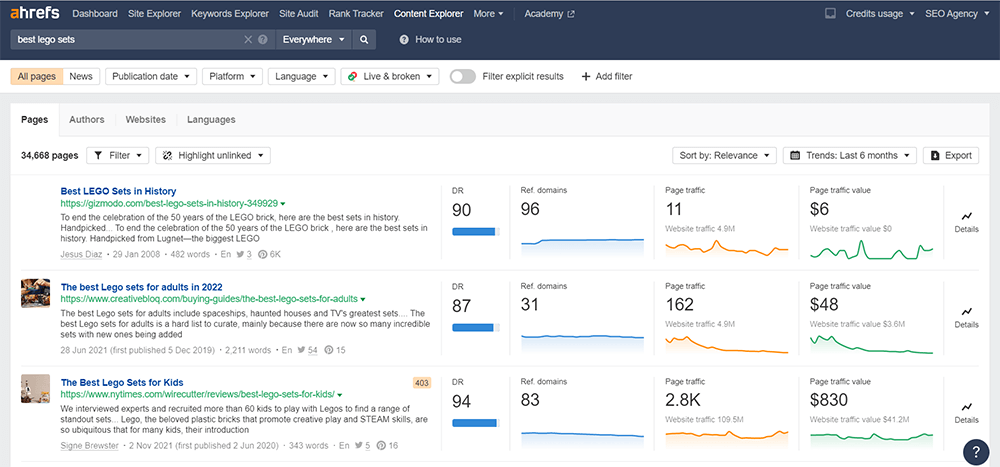
You can also take a more detailed approach and use your Google Analytics to find pages that support your business objectives (recommended for eCommerce sites).
Another quick way to find what your competitors are talking about is by using advanced Google search operators.
All you need to do is search the following in Google: site:competitordomain.com inurl:/blog/ or site:blog.competitordomain.com
You can also filter the results by looking at the most recent articles that they’ve published.
Here’s an example:
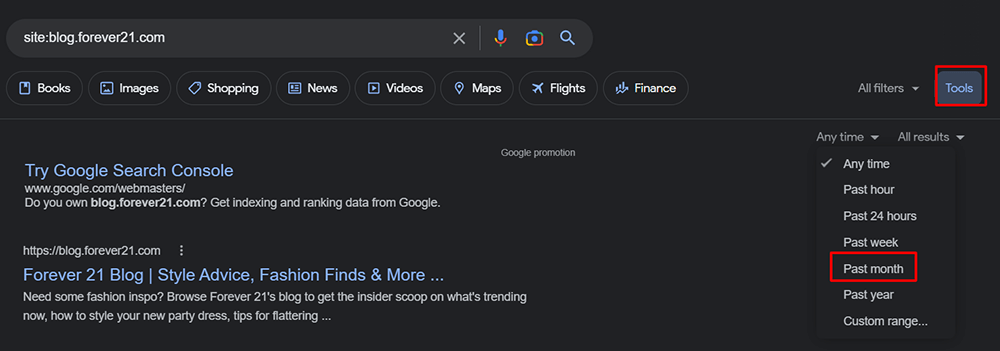
It’s also possible to ask your audience directly via social media channels or emails what they would like to read about.
So yes, there are numerous ways to find the topics your audience might be interested in.
2. Captivating Title
A compelling topic is, unfortunately, not enough to convince someone to even click on your article. After all, you’re likely not the only one writing about that topic.
How to entice someone to click on your blog post, then?
By writing a captivating title heading. It’s the first thing your potential readers notice. If it doesn’t attract their attention, they won’t even consider reading it, no matter how well the content is written.
Let’s take this article as an example.
Imagine that instead of ‘10 Essential Elements of an Exceptional Blog Post,’ the title was ‘Elements of a Blog Post.’ That’s far from calling it captivating, wouldn’t you agree?
Sure, it tells what the article is about, but would you feel interested in reading it? Probably not.
The title used is much more captivating. It includes words like essential and exceptional. They grasp attention, showing that you will actually learn something useful. It states that without these elements, you won’t be able to write an exceptional blog post.
Also, on the bonus side, such words make the title look more exciting. It’s not just a list of elements an average blog post would have. It’s a list of must-have elements an exceptional blog post must contain.
See what we did there?
3. Gripping Introduction
Convincing someone to visit your blog post is a win. A small one, but still a win. The more significant challenge is turning your visitor into a reader, which most bloggers fail to achieve.
In other words, your introduction matters.
The sad reality is that an average reader’s attention spans eight seconds. That’s right. You’ve got eight seconds to convince a user to read the rest of your article. The article you spent 4 hours writing.

That would be an interesting Mission Impossible movie – just Tom Cruise trying to write a gripping introduction to his newest blog post.
And that’s exactly what your article needs. Your introduction must convince the reader that they should keep reading.
A good introduction needs to be direct. Don’t beat about the bush. Tell your readers about the article and how it will help them.
For instance, you can create a hypothetical problem that your article will help resolve. Add a pinch of storytelling, a tablespoon of powerful keywords, and finish with a hook.
Don’t answer all the questions. Provide readers with enough information to make them care and slowly lure them into your story.
You’ve got eight seconds for that. Don’t waste it.
4. Engaging Subheadings
How you structure your article matters.
First, a clear structure will help your reader navigate through the article. And secondly, it makes your content look much more aesthetically appealing.
Think about it. If you throw a block of text into your readers’ faces, they will get lost fast. It even looks off-putting, forcing readers to read every line to find the information they seek.
This is where the subheadings come in. They offer context and serve as visual clues, allowing your readers to navigate through your post easier, ensuring they quickly find the answer to their queries.
What should your blog post structure look like? This graphic from our SEO Textbook sums it up perfectly.
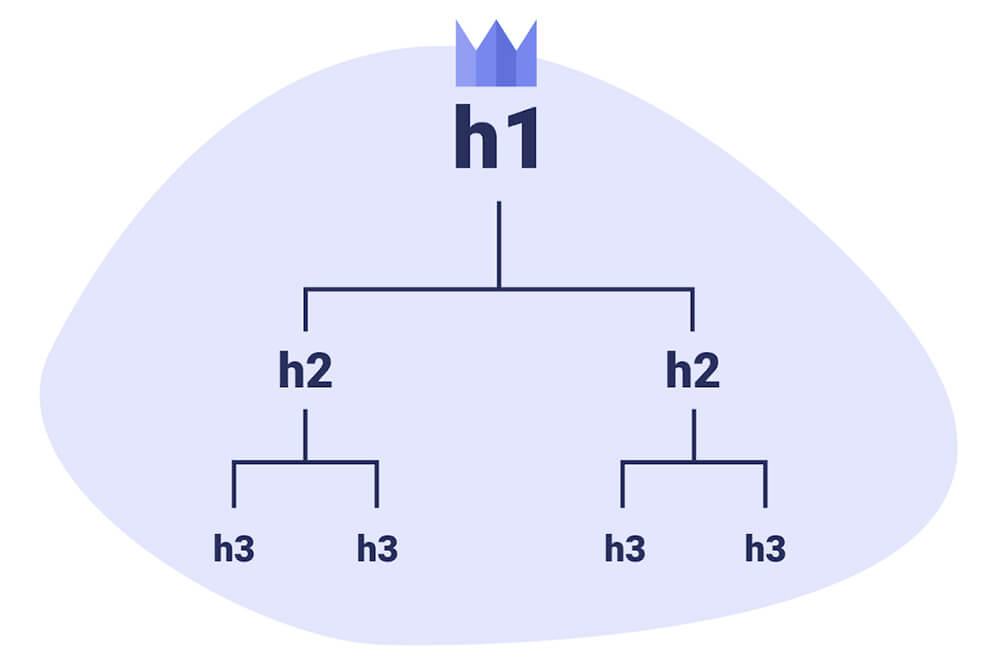
Dividing your structure into several sections using different subheading sizes creates a hierarchical structure for your page. It’s great for both your readers and for SEO.
Oh yes, Google loves well-structured articles. And if your subheadings use the right keywords, well, that’s a home run.
When optimising your subheadings with keywords, remember not to stuff – make them as natural as possible. Ultimately, you’re writing the blog post for the reader, not Google.
Using too many subheadings can make your content challenging to read. The best idea is to always use H2 subheadings and treat H3-H6 headings as optional.
5. Table of Contents
Speaking of subheadings and content structure, don’t forget to add a table of contents to your post, especially if it’s longer than a typical 800-word article.
The table of contents serves two primary purposes.
Improves Navigation
First of all, it helps your readers to navigate through your page. They will be able to quickly locate the part of the article that interests them the most and head straight into it, especially if you use anchor links.
Good For SEO
And secondly, search engines love tables of contents! Google often displays them as sitelinks and pulls them out into SERPs. If you’re looking for a straightforward way to boost your SEO, adding a table of contents is an excellent idea.
Here’s what a typical table of contents looks like based on our article on writing product descriptions:
6. Appealing Visuals
Adding relevant images, videos, or infographics to your content is key to making it more aesthetically pleasing for your audience. Visual aids help break up the text, making it easier for a reader to go through it.
However, there’s much more to visuals than just that.
See, the thing about humans is that they are visual creatures. Indeed, visual learners represent approximately 65% of our entire population.
Simply put, we respond better and faster to visual data than text: 60,000 times faster, to be exact (MIS Research Centre).
These aren’t just interesting facts. These two pieces of information show precisely how essential data visualisation is. Adding images, infographics, gifs, or graphs to your blog post has an immense impact on how readers process and respond to your content.
Visuals will make it easier for your audience to understand what your article is about. And if you put some time and effort into providing appealing images or infographics, readers will be more likely to remember your article.
Of course, you can’t just add any images you like. Make sure they’re relevant, high-quality, and optimised for search engines (use alt images).
7. Relevant Internal and External Links
Without links, there would be chaos.
It sounds a bit dramatic, sure, but it’s 100% true. The lack of links would make navigating through the meanders of the internet an almost impossible task. Let alone finding something useful (there’s a reason why they’re called links).
But are links that important when writing a blog post? Yes, they are.
Links make navigation more intuitive for your readers. They also provide them with additional sources of information that may interest them.
There are two types of links you should implement in your blog post:
- Internal links – These types of links are nothing else than links to materials within your website, such as other blog posts, products, guides, pages, etc.
- External links – Links that lead to other websites are called external links. These are used to provide sources for your citations or included data.
Both types of links, internal and external, play a significant role in your SEO.
Internal links help search engines crawl your website, whereas external links, if they’re high-quality, can help build your site’s credibility.
8. Content Length
How long should your blog post be?
On paper, that seems like a straightforward question. However, once you go on a quest to seek the optimal content length, you will soon find out that the answer is more complex than you anticipated.
Some say it’s 1,000 words. Others say that it must be over 2,000 words. You may also find answers that the best SEO word count is anywhere between 1,500 and 3,000 words.
Which one is it, then?
It doesn’t matter.
Sure, recent studies have shown that longer pieces (2,000+ words) tend to rank higher and generate better results, but there’s no one-size-fits-all word count – especially if you’re optimising for SEO,
In reality, it will depend on the type of your content, your target audience, and your topic.
For example, younger audiences tend to have shorter attention spans. They expect your content to deliver fast and simple answers.
On the other hand, more comprehensive topics may require longer content to explore them in full and generate value for the audience.
The best idea is to either use page depth scroll tracking in Google Analytics, which will help you understand how far your visitors scroll down your blog posts, or analyse the competition.
For the latter, you can use Surfer SEO’s SERP Analyzer tool, which will provide you with information about your competition and their content body length.
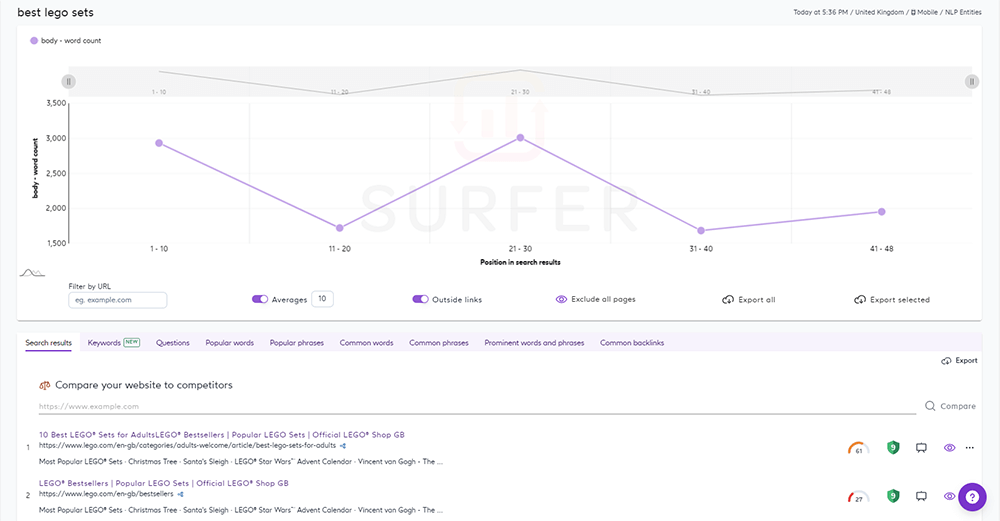
The previously mentioned Content Explorer tool from Ahrefs offers a similar feature, displaying word counts next to the competitors’ examples.
The main takeaway when it comes to word count, is to align your length with what Google is rewarding for the primary keyword that you’re targeting.
9. Strong Summary
Some say that it doesn’t matter how you start but how you finish.
And while it does apply to many situations, blog content writing is not one of them. As discussed, how you start matters the most, but it doesn’t mean you ought to neglect your article’s ending.
Your conclusion is the last chance to make a lasting impression on your reader. It’s also the moment you want to entice readers to take some form of action, such as signing up for a newsletter, following your social media page, or checking out the service or product you offer.
A good conclusion should include key takeaways and, if you want your reader to take the desired action, an engaging CTA (call-to-action).
10. Shareable, SEO-Friendly URL
Before you post your blog article, you need to ensure it comes with the correct URL.
It may not seem like a big deal, but the URL plays a role in SEO. Correctly structured URLs can improve user experience and help search engines crawl and rank your web pages.
Now, as for your content’s URL, it should tell readers and search engines what the blog post is about. It should be short, descriptive, and keyword-rich. Overly complex URLs can even cause issues for crawlers.
That said, instead of making your URL look like this:
https://susodigital.com/blog/26/06/2022/eleven-essential-elements-of-an-exceptional-blog-post-the-2022-guide
It’s better to make it look like this:
https://susodigital.com/blog/essential-elements-of-an-exceptionall-blog-post
Bonus Tip: Schema Markup
Not many similar guides talk about including schema in your blog post. If you care about your SEO, however, it’s a must-have element of any piece of content you publish.
For those unfamiliar with the term, schema markup is structured data that uses a unique semantic vocabulary to help search engines understand better the information on your page and identify the type of your content.
Once search engines recognize the meaning behind your content and the relationship between entities, they can present it as a snippet of your content, providing users with richer results.
For example:
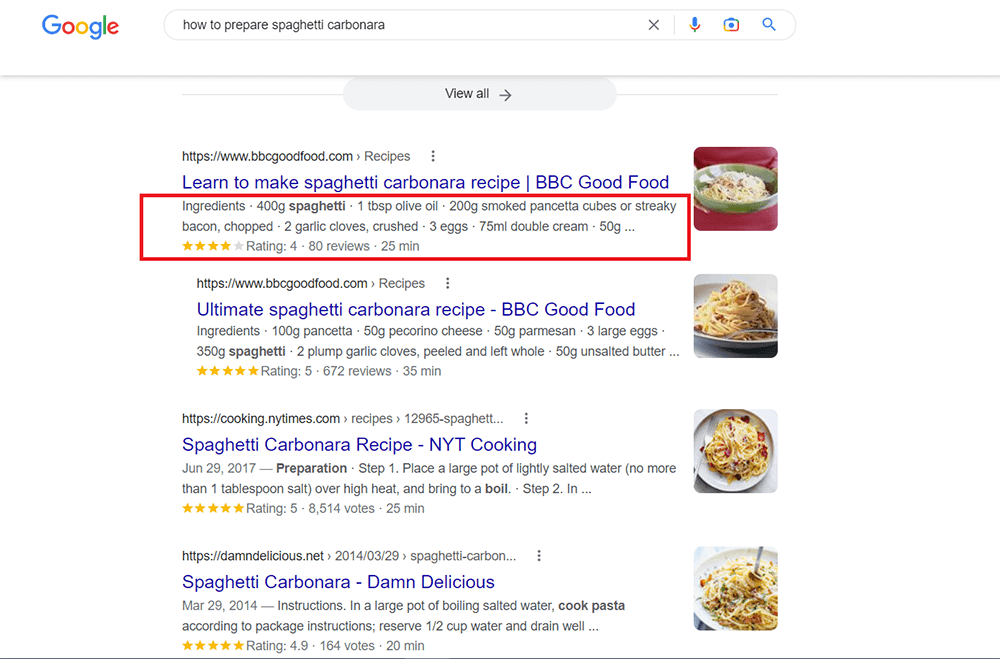
Google understands many types of schema, including an article, FAQ, how-to, or recipe.
A recipe markup displayed above, for example, tells Google that your content is a recipe. Google can then present searchers with a preview of the ingredients necessary to prepare the dish.
The same goes for a how-to markup, where Google will display a preview of each step on the SERP.
For blog posts, you should add Article markup, which allows you specify important information such as the author, headline, publication date etc.
The Bottom Line
And that’s a wrap.
As you can see, writing an exceptional blog post takes much more than just ensuring content is 100% original and top-quality. Yes, it’s vital, and you can’t do much without it, but you already know that.
The goal of this guide was to show you that there’s more to it. The elements described above are must-haves for any blog post you publish, starting with a compelling topic all the way through to the schema markup.
These elements are vital both for your readers and search engines. Don’t neglect them, even if they seem irrelevant to your content.
Once you tick all these boxes and combine them with high-quality content that provides value to your readers, you can rest assured that your blog posts will get noticed and drive traffic to your website.
More articles
View more of our research.

Constructing An eCommerce Website for SEO
Find out how to construct an eCommerce website that is great for users and accessible for search engines.

Educating Clients on the Value of SEO: A Guide for Marketing Managers
Find out how marketing professionals can transform their clients' perception of SEO by educating them about the value that it can bring to their businesses.

